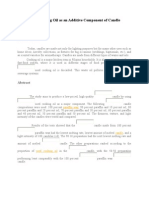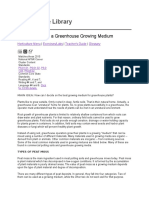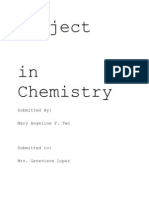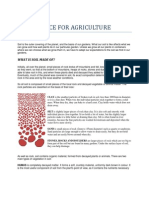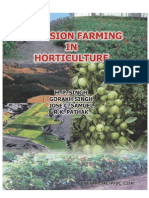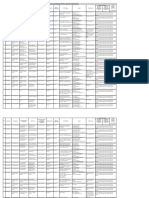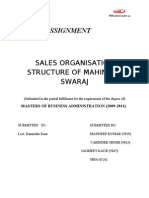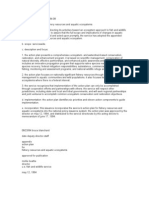Review of Related Literature
Review of Related Literature
Uploaded by
Camille MonteverdeCopyright:
Available Formats
Review of Related Literature
Review of Related Literature
Uploaded by
Camille MonteverdeCopyright
Available Formats
Share this document
Did you find this document useful?
Is this content inappropriate?
Copyright:
Available Formats
Review of Related Literature
Review of Related Literature
Uploaded by
Camille MonteverdeCopyright:
Available Formats
Review of Related Literature
Coconut is a fruit of the coconut palm tree, its trunk is one to two feet in diameter. It has no branches but carries a crown leaves of about 70 to 100 feet above the ground, its leaves is like a feather and with many segments, leaves are usually 10 to 20 feet long. The coconut fruit hang at the bases of the leaves in clusters of about 10 to 15. Several clusters ripen during the year. A tree may produce 200 coconuts a year, but the average is just around 40. Coconut tree grows wild on tropical seacoasts, and is cultivated in moist, frost-free climates, it is abundant in Southeast Asian countries.
How Coconut Tree Grow? Ever wonder how coconut trees can easily increase in numbers? When coconut ripen, they fall from the tree and are frequently washed out to the sea. Some may drift for months before they are cast up by the waves onto the shore. After 4 to 5 months, the seed sprouts and a new tree begins to grow. In about 6 years the tree will begin to bear coconut and it will reach its full bearing time at 20 years. Coconut tree is very strong and it can resist strong typhoons, coconut tree does not also need a lot of maintenance unlike the mango tree which needs a lot of care and fertilizers.
Coconut leaves
Coconut leaves are used for making brooms in India. Guyana as the green of the leaves are stripped away leaving the vein (a wooden-like, thin, long strip) tied together form a broom. The leaves provide materials for baskets and roofing thatch. Leaves can be woven into roofing or mats. Leaves are woven into a basket that can draw well water. Two leaves (especially the younger, yellowish shoots) weaved into a tight shell the size of the palm and infill with rice and cooked - also known as "ketupat" in Malay archipelago. Dried coconut leaves can be burned to ash, which can be harvested for lime. The stiff leaflet midribs can be used to make cooking skewers, kindling arrows, or are bound into bundles, brooms and brushes. The mid-rib of the coconut leaf is used as a tongue-cleaner in Kerala. In India, particularly in Kerala and Tamil Nadu, the woven coconut leaves are used as 'pandals' (temporary sheds) for the marriage functions.
Reference: http://hubpages.com/hub/Uses-of-Coconut-Trees
Liming is the application of calcium- and magnesium-rich materials to soil in various forms, including marl, chalk, limestone, or hydrated lime. This neutralises soil acidity and increases activity of soil bacteria. However, oversupply may result in harm to plant life. Lime is a basic chemical, the effect of it makes the soil more basic thus making acidic soils neutral. The degree to which a given amount of lime per unit of soil volume will increase soil pH depends on the cation exchange capacity (CEC). Soils with low CEC will show a more marked pH increase than soils with high CEC. But the low-CEC soils will witness more rapid leaching of the added bases, and so will see a quicker return to original acidity unless additional liming is done. Over-liming is most likely to occur on soil which has low CEC, such as sand which is deficient in buffering agents such as organic matter and clay. Most acid soils are saturated with aluminium rather than hydrogen ions. The acidity of the soil is therefore a result of hydrolysis of aluminium. This concept of "corrected lime potential to define the degree of base saturation in soils became the basis for procedures now used in soil testing laboratories to determine the "lime requirement" of soil.
Reference: http://en.wikipedia.org/wiki/Liming_(soil)
You might also like
- Hanging Plants: Creating Kokedama for the HomeFrom EverandHanging Plants: Creating Kokedama for the HomeRating: 4 out of 5 stars4/5 (3)
- Class 4 - SCIENCE CHAPTER 2Document8 pagesClass 4 - SCIENCE CHAPTER 2smile100% (3)
- Aquarium Plant GrowthDocument59 pagesAquarium Plant Growthhoticeforu100% (1)
- Chapter IDocument17 pagesChapter IChristian MeanaNo ratings yet
- Unit 3 - CoconutDocument9 pagesUnit 3 - CoconutAnonymous KR79Kr5No ratings yet
- Features of Good Filing Systems: Standard Grade Administration Unit 3aDocument9 pagesFeatures of Good Filing Systems: Standard Grade Administration Unit 3aknoxbusinessNo ratings yet
- A Feasibility Study of Fallen Leaves As An AlternaDocument3 pagesA Feasibility Study of Fallen Leaves As An AlternaFaiza Alimuddin100% (1)
- Products Utilization From BananaDocument37 pagesProducts Utilization From BananaShauQi Lutfi100% (1)
- Portable Cacao Bean SorterDocument4 pagesPortable Cacao Bean SorterDeteu Cabadonga100% (1)
- Used Cooking Oil As An Additive Component of CandleDocument3 pagesUsed Cooking Oil As An Additive Component of Candle03jayvee110% (1)
- Banana Fiber As Art Paper AlternativeDocument4 pagesBanana Fiber As Art Paper Alternativebella maxNo ratings yet
- BananaDocument31 pagesBananaPuja BadheNo ratings yet
- Advantages and Disadvantages of Alternative EnergyDocument5 pagesAdvantages and Disadvantages of Alternative EnergyAntoniaHernanzNo ratings yet
- Significance of The StudyDocument2 pagesSignificance of The StudyG-Ignacio, Krizelle Fame V.No ratings yet
- Banana Peel As Alternative of Making JamDocument7 pagesBanana Peel As Alternative of Making JamArya YusrilNo ratings yet
- Trend Analysis and Other Data Analytics For BambooDocument19 pagesTrend Analysis and Other Data Analytics For BambooAnne CuadernoNo ratings yet
- Appendix A Household Food Waste Questionnaire in English Avalidated Survey To MeasureDocument10 pagesAppendix A Household Food Waste Questionnaire in English Avalidated Survey To MeasureTitis Retno Sawitri SawitriNo ratings yet
- Paper Production From Banana Stem PDFDocument5 pagesPaper Production From Banana Stem PDFJames Laurence Raviz67% (3)
- Lotus Care 2020Document3 pagesLotus Care 2020სალომე გოგიაშვილიNo ratings yet
- Chapter 7 Adaptation of Plants in Different HabitatsDocument24 pagesChapter 7 Adaptation of Plants in Different HabitatsMARLIANA IRYANI BINTI YAACOB KPM-GuruNo ratings yet
- MR EcologyDocument4 pagesMR Ecologymeilvi19No ratings yet
- Chapter 7.0Document7 pagesChapter 7.0ayris.mohdkNo ratings yet
- Adaptations of MangrovesDocument3 pagesAdaptations of MangrovesLeonard Lennox100% (1)
- A Beginner's Guide to Annuals and Biennials: Essential guide for A Beautiful GardenFrom EverandA Beginner's Guide to Annuals and Biennials: Essential guide for A Beautiful GardenNo ratings yet
- Lesson 20 Soil and WaterDocument19 pagesLesson 20 Soil and WaterAnne Minnette DastasNo ratings yet
- FINAL Structure of PlantsDocument42 pagesFINAL Structure of PlantsCatherine Lagario RenanteNo ratings yet
- WATERDocument4 pagesWATERKristine AbelladaNo ratings yet
- Facts About The Coconut TreeDocument14 pagesFacts About The Coconut TreeTino SalabsabNo ratings yet
- Water in PermacultureDocument9 pagesWater in PermacultureGabrielArvinte100% (1)
- Persuasive SpeechDocument2 pagesPersuasive Speechernesto Noval JrNo ratings yet
- ht211 Selecting A Greenhouse Growing MediumDocument6 pagesht211 Selecting A Greenhouse Growing Mediumapi-303043588No ratings yet
- Cactus (Cactaceae) : CharacteristicsDocument3 pagesCactus (Cactaceae) : CharacteristicsImelia IsmailNo ratings yet
- Media For The Cultivation of Green House Plants: Dr. P. Syam Sundar ReddyDocument42 pagesMedia For The Cultivation of Green House Plants: Dr. P. Syam Sundar ReddysyamkavithaNo ratings yet
- Feasibility Study of Establishing A Coconut Lumber Processing Plant in The Pomio District of East Britain2Document19 pagesFeasibility Study of Establishing A Coconut Lumber Processing Plant in The Pomio District of East Britain2rooker77No ratings yet
- Certificate of ProjectDocument4 pagesCertificate of ProjectAmbeya NoorulNo ratings yet
- Aquatic Plants PowerpointDocument9 pagesAquatic Plants PowerpointjaNo ratings yet
- Science 4 Modules - Q4 (Sir Aljon)Document11 pagesScience 4 Modules - Q4 (Sir Aljon)Nojla SenoirbNo ratings yet
- Water PlantsDocument7 pagesWater PlantsKristine Joyce NodaloNo ratings yet
- Daun KetapangDocument88 pagesDaun KetapanglefidusNo ratings yet
- Plants AdaptationsDocument43 pagesPlants AdaptationsWa TontonNo ratings yet
- AE 101 Review Matls Plant Soil H2ODocument80 pagesAE 101 Review Matls Plant Soil H2Ogelinec.runasNo ratings yet
- Group #01Document40 pagesGroup #01Neelam GhilzaiNo ratings yet
- 7 Adaptations of Plants 2021Document16 pages7 Adaptations of Plants 2021seth82024No ratings yet
- Growing Media of Horticulture Crops For Green House CultivationDocument6 pagesGrowing Media of Horticulture Crops For Green House CultivationPrasenjit PaulNo ratings yet
- 09 Water in Permaculture PDFDocument10 pages09 Water in Permaculture PDFZara HoNo ratings yet
- 1.1 Background: Orang Utan, Sumatra Tiger, Elephant, Peacock. Our Plant Has A Various Plant IncludeDocument23 pages1.1 Background: Orang Utan, Sumatra Tiger, Elephant, Peacock. Our Plant Has A Various Plant IncludeArsyi AmriansyahNo ratings yet
- Science ProjectDocument9 pagesScience ProjectfilqueenNo ratings yet
- PPT - Adaptation in Plants - NewDocument78 pagesPPT - Adaptation in Plants - Newpriyal sherekarNo ratings yet
- Avocado TipsDocument11 pagesAvocado TipsKristine Mae OliverosNo ratings yet
- Download full Cleopatra in Space 1st Edition Mike Maihack ebook all chaptersDocument75 pagesDownload full Cleopatra in Space 1st Edition Mike Maihack ebook all chapterssliceziatskw100% (2)
- The Mysteries of Moving Water & Trees Age GracefullyDocument7 pagesThe Mysteries of Moving Water & Trees Age GracefullyAyushi AroraNo ratings yet
- Bio Term PaperDocument8 pagesBio Term PaperJelord Rey GulleNo ratings yet
- IndianLotus AMulti purposeAquaticOrnamentalPlant.Document4 pagesIndianLotus AMulti purposeAquaticOrnamentalPlant.Smit kalamkarNo ratings yet
- Soil Science For AgricultureDocument11 pagesSoil Science For AgricultureNarender SaineniNo ratings yet
- Adaptions of plantsDocument2 pagesAdaptions of plantsBRIANNA AVA GERALD MoeNo ratings yet
- Bio GDDocument2 pagesBio GD11176No ratings yet
- Upsc EssaysDocument218 pagesUpsc EssaysvetthamilNo ratings yet
- FN 11 Prelab: Adobong PusitDocument4 pagesFN 11 Prelab: Adobong PusitToppogirlNo ratings yet
- Deforestation: LandslideDocument3 pagesDeforestation: LandslideKrezel Kaye Calawigan BarbadilloNo ratings yet
- Heritage Tourism Handbook:: A How-To-Guide For GeorgiaDocument68 pagesHeritage Tourism Handbook:: A How-To-Guide For GeorgiaShabby100% (1)
- E-BookPrecisionFarming in HorticultureDocument363 pagesE-BookPrecisionFarming in HorticultureBilal Arshad100% (21)
- SR - Q3 2023 Goat Situation Report - SignedDocument17 pagesSR - Q3 2023 Goat Situation Report - Signedbeatrizmarifer1023No ratings yet
- PROJECTDocument2,449 pagesPROJECTmadhuresh.guptaNo ratings yet
- Lesso n4: The Kinds of Research Across FieldsDocument4 pagesLesso n4: The Kinds of Research Across FieldsCory Bulawit Silva-LasdoceNo ratings yet
- List of FPOs in The State of MaharashtraDocument5 pagesList of FPOs in The State of Maharashtramailsk123100% (1)
- DapitanDocument3 pagesDapitanchingchongNo ratings yet
- Assignment: Sales Organisation Structure of Mahindra SwarajDocument9 pagesAssignment: Sales Organisation Structure of Mahindra SwarajkaranvirkalraNo ratings yet
- 307 Power Point Banana BreadDocument30 pages307 Power Point Banana Breadapi-279112230No ratings yet
- Environment Friendly Life Styles A Dialogue With Ancient IndiaDocument18 pagesEnvironment Friendly Life Styles A Dialogue With Ancient IndiaAnonymous LsyWN2oJNo ratings yet
- FIRST QUARTER TEST IN TLE-Agriculture 6 (Ver4)Document4 pagesFIRST QUARTER TEST IN TLE-Agriculture 6 (Ver4)ydel pascua100% (1)
- Strength and Ductility of Randomly Distributed Palm Fibers Reinforced Silty-Sand SoilsDocument12 pagesStrength and Ductility of Randomly Distributed Palm Fibers Reinforced Silty-Sand SoilsRichter Opoku Boahen0% (1)
- AmmoniaDocument5 pagesAmmoniaJulia BarabasiNo ratings yet
- How To Make Amrut JalDocument3 pagesHow To Make Amrut JalgreengrassglassNo ratings yet
- Critique PaperDocument3 pagesCritique PaperMildred BongabongNo ratings yet
- Nutrient Management For Enhancing ProducDocument105 pagesNutrient Management For Enhancing Producrina301288No ratings yet
- HELE Grade 5-2nd QuarterDocument4 pagesHELE Grade 5-2nd QuarterNanay Gi100% (3)
- CSR PresentationDocument13 pagesCSR PresentationSANDEEP SINGH50% (2)
- MozambiqueDocument20 pagesMozambiqueSabin ConstantinNo ratings yet
- The Story of A DonkeyDocument72 pagesThe Story of A DonkeyLoja EthnicaNo ratings yet
- Evaluation of The PPPIAD Project On CottonDocument56 pagesEvaluation of The PPPIAD Project On CottontarakdhurjatiNo ratings yet
- 2 Terminology To Philosophy of ExtensionDocument79 pages2 Terminology To Philosophy of ExtensionQuinnee Vallejos100% (2)
- State PCS CA Consolidation (Bihar) October 2023Document23 pagesState PCS CA Consolidation (Bihar) October 2023Divyanshu KumarNo ratings yet
- BWHW Adapted-Novel ProjectIMPACTDocument139 pagesBWHW Adapted-Novel ProjectIMPACTnathalycalderon549No ratings yet
- Mangrove Ecosystems in Western Madagascar: An Analysis of Vulnerability To Climate Change (WWF/2011)Document24 pagesMangrove Ecosystems in Western Madagascar: An Analysis of Vulnerability To Climate Change (WWF/2011)HayZara MadagascarNo ratings yet
- Action Plan For Fishery Resources and Aquatic EcosystemsDocument8 pagesAction Plan For Fishery Resources and Aquatic Ecosystemsapi-3696178No ratings yet
- Handout 105Document2 pagesHandout 105Alexis Tondo AlmadronesNo ratings yet









